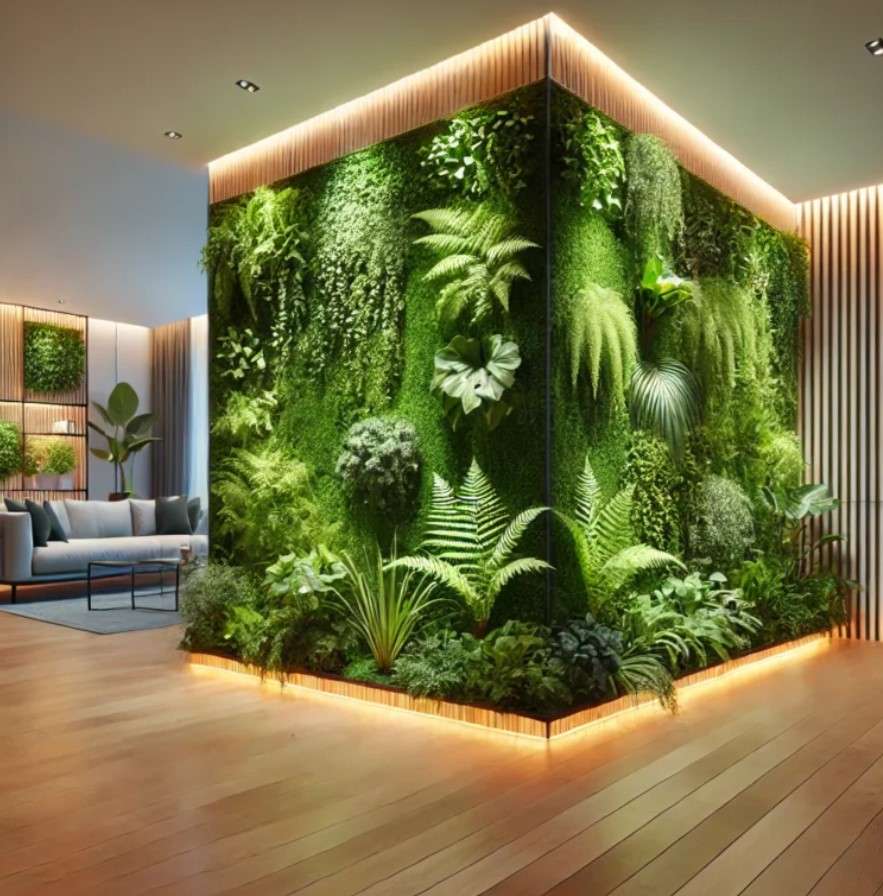Vertical gardens are no longer just for urban rooftops or public spaces; they’re making their way into interior design as an eco-friendly and visually striking trend. These living walls or green walls, which use plants to create vertical displays of greenery, are revolutionizing how we think about nature in the home. Not only do vertical gardens bring a fresh, organic element to interiors, but they also offer a range of scientific benefits, from air purification to improved mental well-being. In this blog, we dive into the science of vertical gardens and how you can integrate them into your home for a truly innovative living space.

The Science Behind Vertical Gardens
Vertical gardens mimic the natural processes of plant growth, but in a more compact and efficient way. Plants are placed in a vertical structure, using soil or hydroponic systems to support their growth. This allows for the cultivation of a variety of plants in a smaller footprint, ideal for apartments or homes with limited space. Scientifically, plants improve air quality by absorbing carbon dioxide and releasing oxygen, which helps reduce indoor air pollution. They can also filter toxins like formaldehyde, benzene, and ammonia, creating a healthier indoor environment.
Benefits of Vertical Gardens in Interiors
Improved Air Quality: Plants naturally filter the air, removing harmful toxins and providing oxygen. This can result in a cleaner, fresher environment within your home, especially in spaces with limited ventilation.
Enhanced Aesthetics: A vertical garden adds a lush, green element to your interior decor. Whether as a focal point in the living room, an accent wall in the kitchen, or even in a home office, it enhances the visual appeal of any room.
Sound Insulation: Plants help reduce noise pollution by absorbing sound waves. A living wall can act as a natural sound barrier, particularly in busy or noisy environments, offering a peaceful and quiet space.
Mental Well-being: Numerous studies have shown that being surrounded by nature, or even viewing natural greenery, can reduce stress levels and improve overall mental health. A vertical garden can bring this therapeutic effect into your home, creating a calming atmosphere.
Energy Efficiency: Vertical gardens can also help with energy efficiency. In the summer, they provide natural shade, reducing heat absorption by the walls and decreasing the need for air conditioning. In colder months, they can insulate your space, maintaining warmth and minimizing energy loss.
How to Create Your Own Vertical Garden
Creating a vertical garden in your home is easier than it seems. Here are some essential tips to get started:
Choose the Right Plants: Start by selecting plants that thrive in your indoor environment. Low-maintenance varieties such as ferns, ivy, succulents, and pothos are great for beginners. For those seeking more color and variety, consider adding flowering plants like peace lilies or begonias.
Pick a Suitable Location: Vertical gardens work well in areas with good natural light. Consider placing your garden in spaces that don’t receive direct sunlight, as the plants will need enough light to grow, but not too much heat.
Select the Right System: Vertical garden systems come in several options, from modular panels to hydroponic towers or pocket planters. Choose one that fits your space, style, and the level of maintenance you’re comfortable with. Modular systems allow for easy customization and expansion as your garden grows.
Watering and Maintenance: Most vertical garden systems are designed with built-in irrigation, but you’ll still need to water your plants regularly. Ensure that your system has proper drainage to prevent waterlogging. Regular pruning and cleaning of leaves will keep the garden looking neat and healthy.
Design and Style: Vertical gardens can be as minimalist or as decorative as you like. Consider integrating your vertical garden with other design elements like modern planters, shelves, or frames to create a visually appealing display. You can also mix plants with other textures like wood, stone, or metal for added interest.
Challenges of Vertical Gardens
While vertical gardens offer many benefits, there are a few challenges to keep in mind. One of the main concerns is maintaining the right balance of light, water, and air circulation. Without proper care, plants can become overwatered or dry out. Additionally, it’s essential to choose the right plant varieties that can thrive in the indoor conditions of your home.
Another challenge is the installation process. Although modular systems make it easier, creating a fully functional vertical garden may require professional installation, especially for larger or more complex systems. It’s important to choose a system that fits your skill level and maintenance preferences.



